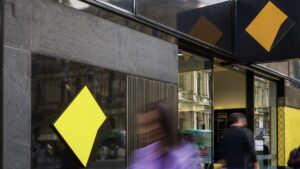CRITERION: Looking beyond the blue chips for decent dividend yields

Pic via Getty Images
- Australian investors currently are pocketing $35 billion of dividends, but yields are falling
- Smaller industrial stocks with a decent dividend record are yielding up to 10 per cent
- Beware the ‘dividend traps’
Investors are about to have their pockets filled with dividend largesse – mainly from the blue chip end of the market – but are better rewards on offer?
According to Commonwealth Securities, just under $35 billion will be paid – or was dispensed – in divs between August and October.
This sum is 5 per cent up on last year’s tally.
But yields are forecast to decline this financial year, either because companies don’t expect to do so well and will crimp their payouts, or because of share price appreciation (which is not such a bad thing).
The banks – the most popular source of reliable divs – are forecast to yield an average 4.2 per cent, plus a 1.8 per cent franking credit is considered.
But brokers put the allegedly overvalued Commonwealth Bank (ASX:CBA) – the most important single source of investor income – on a forward yield of a mere 3.4 per cent (albeit fully franked).
Across the ASX 200 stocks, yields are forecast at 3.6 per cent, well below the long-term average of 4.5 per cent since 2000.
Look beyond the blue-chip faves
In reality, most investors will hang on the bank shares and the old dividend faves Telstra (ASX:TLS), Wesfarmers (ASX:WES), Woolworths (ASX:WOW) and Coles Group (ASX:COL) to fund their retirement.
But sometimes it pays to stray from the worn path, especially as waning consumer sentiment is likely to affect these domestical-focused stalwarts.
In their quest for higher yields, investors need to be cautious about taking published figures at face value.
The payouts simply may not be sustainable, or the company’s business is cyclical, such as resources. Fortescue Metals Fortescue Metals Group (ASX:FMG) , for instance, yields about 8 per cent now but with wilting iron prices that’s expected to abate to around 5 per cent this year.
Formerly IOOF, wealth adviser Insignia Financial (ASX:IFL) was on a double-digit yield a couple of years ago, but in August it “paused” its dividend “to enhance strategic and balance sheet flexibility.”
Consider these …
That said, there are plenty of small to mid-caps yielding 6 per cent more with reasonable prospects.
While Transurban Group (ASX:TCL) yields 4.5 per cent, European and US toll road operator Atlas Arteria (ASX:ALX) returns around 7 per cent. European toll pricing is government-regulated, which means regular agreed price increases.
In the property trust sector, Centuria Office REIT (ASX:COF) yields more than 10 per cent, although investors need to decide whether the office rout is abating or only just beginning.
A safer bet might be the Hotel Property Investments (ASX:HPI) , which owns 60 properties – mainly pubs -on a 6.5 per cent yield which sure beats the pokies.
Straying fom the big banks – and indeed our shores – BSP Financial (ASX:BFL) is Papua New Guinea’s biggest bank, while Kina Securities (ASX:KSL) is a pre-eminent bank and wealth manager in the island nation.
Kina yields 10 per cent and BSP returns around 8.5 per cent. The stocks trade at an inevitable discount for operating in troublesome PNG, but their capital adequacy and loan performance would make a Big Four banker blush.
Formerly known as Money3, Solvar (ASX:SVR) provides unsecured consumer and personal credit, notably car loans. Despite Solvar crimping its payout after a 64 per cent earnings decline, the stock still yields around 8 per cent.
With a similar yield, Cash Converters (ASX:CCV) , which is best known for its network of 670 pawn shops here and in the UK, but earns more from its $288 million consumer and SME loan book.
Wealth manager Platinum Asset Management (ASX:PTM) has seen better days, but pays a yield nudging 10 per cent while management’s turnaround magic works.
… but tread carefully
Do watch those dividend traps, though.
As IG Markets puts it: “many investors are caught out by the siren song of ultra-high yield percentages without considering the whole picture.”
This story does not constitute financial product advice. You should consider obtaining independent advice before making any financial decision.
Related Topics
UNLOCK INSIGHTS
Discover the untold stories of emerging ASX stocks.
Daily news and expert analysis, it's free to subscribe.
By proceeding, you confirm you understand that we handle personal information in accordance with our Privacy Policy.








